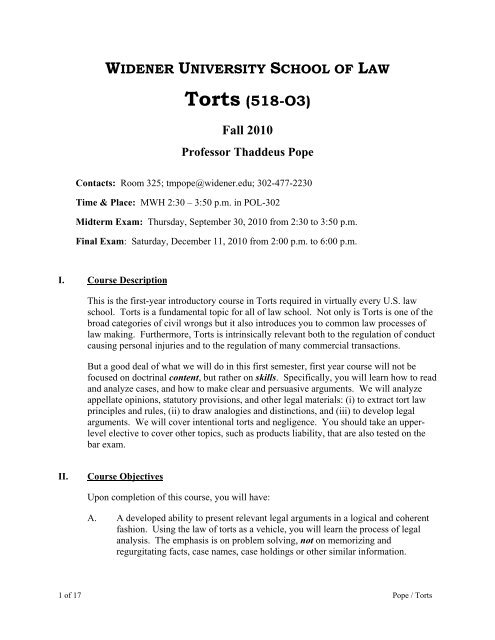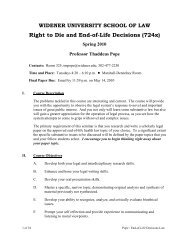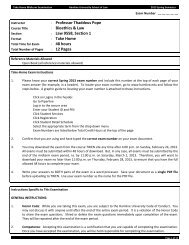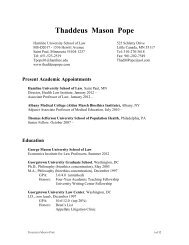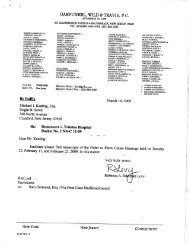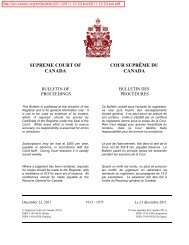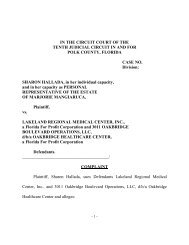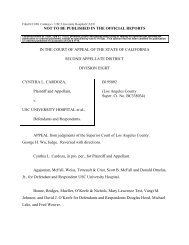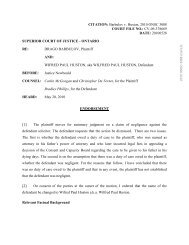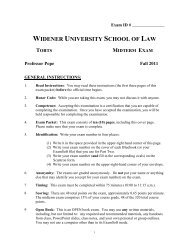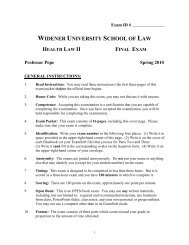Torts (518-O3) - Thaddeus Pope
Torts (518-O3) - Thaddeus Pope
Torts (518-O3) - Thaddeus Pope
You also want an ePaper? Increase the reach of your titles
YUMPU automatically turns print PDFs into web optimized ePapers that Google loves.
WIDENER UNIVERSITY SCHOOL OF LAW<br />
<strong>Torts</strong> (<strong>518</strong>-<strong>O3</strong>)<br />
Fall 2010<br />
Professor <strong>Thaddeus</strong> <strong>Pope</strong><br />
Contacts: Room 325; tmpope@widener.edu; 302-477-2230<br />
Time & Place: MWH 2:30 – 3:50 p.m. in POL-302<br />
Midterm Exam: Thursday, September 30, 2010 from 2:30 to 3:50 p.m.<br />
Final Exam: Saturday, December 11, 2010 from 2:00 p.m. to 6:00 p.m.<br />
I. Course Description<br />
This is the first-year introductory course in <strong>Torts</strong> required in virtually every U.S. law<br />
school. <strong>Torts</strong> is a fundamental topic for all of law school. Not only is <strong>Torts</strong> is one of the<br />
broad categories of civil wrongs but it also introduces you to common law processes of<br />
law making. Furthermore, <strong>Torts</strong> is intrinsically relevant both to the regulation of conduct<br />
causing personal injuries and to the regulation of many commercial transactions.<br />
But a good deal of what we will do in this first semester, first year course will not be<br />
focused on doctrinal content, but rather on skills. Specifically, you will learn how to read<br />
and analyze cases, and how to make clear and persuasive arguments. We will analyze<br />
appellate opinions, statutory provisions, and other legal materials: (i) to extract tort law<br />
principles and rules, (ii) to draw analogies and distinctions, and (iii) to develop legal<br />
arguments. We will cover intentional torts and negligence. You should take an upperlevel<br />
elective to cover other topics, such as products liability, that are also tested on the<br />
bar exam.<br />
II.<br />
Course Objectives<br />
Upon completion of this course, you will have:<br />
A. A developed ability to present relevant legal arguments in a logical and coherent<br />
fashion. Using the law of torts as a vehicle, you will learn the process of legal<br />
analysis. The emphasis is on problem solving, not on memorizing and<br />
regurgitating facts, case names, case holdings or other similar information.<br />
1 of 17 <strong>Pope</strong> / <strong>Torts</strong>
B. An understanding of the basic legal principles and issues commonly encountered<br />
in tort law. (But please note that a command of the “black letter” rules, while<br />
necessary, is not sufficient for success.)<br />
C. An ability to apply the basic “black letter” rules to new fact patterns. This<br />
includes the abilities both to identify and to analyze legal issues relating to<br />
unfamiliar sets of facts.<br />
C. Competency in tackling a majority of the <strong>Torts</strong> MBE and essay questions on the<br />
bar exam.<br />
D. Further honed legal analysis and writing abilities, through: (i) exposure to and<br />
critique of legal arguments in judicial opinions, legislative reports, and scholarly<br />
writing; (ii) participation in classroom discussion; (iii) completion of and<br />
feedback on weekly problems; (iv) completion of and feedback on a written<br />
midterm examination; and (v) completion of and feedback on a written final<br />
examination.<br />
III.<br />
Required Materials<br />
A. Primary casebook: VICTOR E. SCHWARTZ, KATHRYN KELLY & DAVID F.<br />
PARTLETT, PROSSER, WADE AND SCHWARTZ’S TORTS: CASES AND MATERIALS<br />
(11 th ed. Foundation 2005) (ISBN-13: 978-1587788741).<br />
[NB: While the bookstore stocked the 2010, 12 th edition of the casebook, I<br />
ordered the 11 th edition. For those portions that we will use in this class, the two<br />
editions are nearly identical. I posted this information with the first assignment<br />
and in an email to the class in late July.]<br />
B. Black letter hornbook: KENNETH S. ABRAHAM, THE FORMS AND FUNCTIONS OF<br />
TORT LAW (3d ed. Foundation 2007) (ISBN-13: 9781599412009).<br />
C. Litigation documents: I will post additional and more current materials (e.g.<br />
pleadings, judicial opinions, articles) to the course TWEN site.<br />
IV.<br />
Class Schedule<br />
A. The class will meet on Mondays, Wednesdays, and Thursdays from 2:30 to 3:50<br />
p.m. in POL-302.<br />
B. The class will not meet on the following dates: (i) Monday, September 6 th due to<br />
Labor Day; (ii) Wednesday, October 20 th due to a conference conflict;<br />
(iii) Thursday, October 21 st due to a conference conflict; (iv) Wednesday, October<br />
27th due to Professionalism Day; (v) Thursday, November 4 th due to a conference<br />
2 of 17 <strong>Pope</strong> / <strong>Torts</strong>
conflict; (vi) Wednesday, November 24 th due to Thanksgiving; and (vii) Thursday<br />
November 25 th due to Thanksgiving. The last class of the semester meets on<br />
Monday, December 6 th .<br />
C. To makeup for some of the above missed sessions, we will do two things. First, I<br />
have, with the permission of the Registrar, added five minutes to the end of each<br />
class session. Second, I will post podcasts on some material.<br />
D. Depending on class interest, I am happy to schedule an extra “review” class<br />
during the weeks before the final exam. Please email your questions to me 24<br />
hours before such session to better enable me to answer them. I am also happy to<br />
meet, at any time during the semester, both with individual students in my office,<br />
and with small groups in the 3 rd Floor Faculty Conference Room.<br />
V. What to Do First – at the Beginning of the Semester<br />
A. Purchase the two required books.<br />
B. Register for the TWEN site with the email address that you use most regularly.<br />
C. If you have not used TWEN before, review the student user guide:<br />
http://west.thomson.com/productdetail/1-5704-5/RM157045/productdetail.aspx<br />
D. Calendar key course dates into your planner.<br />
E. Register with the Registrar to type your midterm and final exams (recommended<br />
but not required).<br />
F. Familiarize yourself with the following terms through a legal dictionary (like<br />
Black’s or Wex). Litigation procedure: complaint, directed verdict, summary<br />
judgment, demurrer, answer, motion to dismiss, preponderance of the evidence.<br />
Judicial decision making: precedent, common law, dicta, remand, holding,<br />
appellant/appellee, majority opinion, concurring opinion, dissenting opinion, de<br />
novo, prima facie, question of fact, question of law.<br />
VI.<br />
Attendance, Preparation, and Participation<br />
A. Attendance: Under American Bar Association rules, 80% attendance is required<br />
to allow you to write the final exam. Attendance will be taken by passing class<br />
lists for signature at the start of each class session. This course meets 40 times; so<br />
you may not miss more than 8 classes.<br />
B. Class Preparation: I employ only a moderate amount of lecture but lots of case<br />
method questions and problems. Consequently, students must come to class<br />
3 of 17 <strong>Pope</strong> / <strong>Torts</strong>
prepared to discuss the material assigned. All assigned cases must be read and<br />
briefed. Analyze each case using the following headings: (i) essential substantive<br />
facts, (ii) procedural posture, (iii) issues, (iv) legal principles, (v) reasoning and<br />
(vi) holding. All note problems must be considered before the applicable class<br />
session. You do not need to know the correct answer (if there is one), but know<br />
the reading material and make a reasonable effort to think about the issues raised.<br />
C. Preparation Time: It is impossible to say exactly how much time you will need<br />
for class preparation, since each person’s needs are different. But it is likely that<br />
you will need around three hours of preparation for each class. This includes:<br />
reading the casebook, briefing the cases, reading the hornbook, consolidating<br />
prior notes, taking the weekly quiz, and taking practice CALI questions.<br />
D. Warning about Class Preparation: Brief the cases yourself. Do not make use of<br />
commercially prepared outlines before writing your own brief. As Professor<br />
DeWolf (at Gonzaga Law) explains, “they are like narcotics. Initially they make<br />
you feel good (by taking away your anxiety), but precisely for that reason they<br />
have a corrosive effect upon your learning. It is as though you were taking violin<br />
lessons, and instead of playing the scales you were assigned by your teacher, you<br />
bought a tape of Itzak Perlman playing those scales.”<br />
E. Warning about the Casebook: The value of the case opinions in the casebook is<br />
instrumental only. These cases introduce you to the “black letter” rules and<br />
illustrate how these rules can be applied to a particular fact situation. You will be<br />
tested (both here and on the bar exam) not on the holdings of these or any<br />
particular cases, but rather on your ability to apply the rules to new fact patterns.<br />
That skill can be best developed by doing rather than by observing legal analysis.<br />
Consequently, I will pose “hypos” in class, and I will give you problems on the<br />
weekly quizzes, midterm exam, and final exam. Ideally, you will engage in still<br />
additional practice by looking at my old exams, CALI lessons, and other<br />
materials.<br />
F. Class Participation: All students are expected to participate in class discussions.<br />
Sometimes this will be through “clickers” like PollAnywhere. Other times, it will<br />
be by “cold calling.” If illness or emergency prevents you from being fully<br />
prepared, please notify me before class. I reserve the right to reward<br />
extraordinary and exemplary class participation by raising your grade one step<br />
(e.g. B+ to A-). Typically, around 10% of the class receives such a grade<br />
“bump.” Unfortunately, given the mandatory grading curves, I must impose<br />
limits and cannot reward all commendable levels of participation in this way.<br />
G. Meandering Discussion: I want to leave discussion sufficiently free so that you<br />
discover key points on your own and feel ownership in lessons learned. Still, I<br />
must exert control over class discussion to ensure that you are exposed to key<br />
points and to ensure that you are not confused by a discussion that runs too long<br />
or too tangentially. If we did not get to them, I am happy to explore your<br />
questions outside class in any of the ways described in section XII below.<br />
4 of 17 <strong>Pope</strong> / <strong>Torts</strong>
H. Laptops: I will use an instant-poll tool in which the entire class “votes” on the<br />
answers to orally-posed problems through a browser-supported template.<br />
Accordingly, laptops are welcome. If you do not bring a laptop, I expect that you<br />
can “vote” through a neighbor’s laptop (after refreshing the browser) or through<br />
your cell phone.<br />
I. TWEN Participation: Students are encouraged to participate not only in class but<br />
also through the TWEN discussion boards. Start a new thread or comment on one<br />
already in progress. The best posts: (i) are full of insight and analysis (critical<br />
thinking), (ii) reference course materials, and (iii) are clearly written (organization<br />
& style).<br />
J. Volunteering: I will frequently ask a question that stumps the person whom I<br />
have called on. I will give that person time to think about the question, and see if<br />
they can come up with an answer. It will sometimes happen that you have an<br />
answer, and instinctively raise your hand to volunteer. I may or may not call on<br />
you at that moment. I would prefer your attempt to answer than mine, but best of<br />
all is to continue the dialogue with the student who was initially called on.<br />
Nonetheless, to move things along I may let the volunteer help. Please be<br />
sensitive to the fact that the student who is called on often suffers from stage<br />
fright, and the most obvious things slip from their mind.<br />
K. Ask Questions: I begin each class by asking for both administrative and<br />
substantive questions. If you want to know what pages we will cover, please ask.<br />
If you are having trouble grasping a particular doctrine, please ask. Alternatively,<br />
send an email or start a discussion thread on TWEN.<br />
L. Show & Tell: The topics in this class are constantly in the news and in the plot<br />
lines of movies and broadcast shows. If you notice a story that illustrates or<br />
discusses a class topic, please send me an email or post it to a discussion thread<br />
on TWEN.<br />
L. Outlining: The traditional method of exam preparation for law students involves<br />
making an outline of all course material. After every unit of material (e.g.<br />
battery), but at least every two weeks, you should review and consolidate your<br />
casebook notes, class notes, and other material into an outline, flowchart, or other<br />
document. Furthermore, you should aim to edit this growing document every<br />
time you add to it, both to improve the organization and to clarify the content.<br />
VII.<br />
Classroom Etiquette<br />
A. The classroom environment must be conducive to learning for all students.<br />
Distractions made possible by advances in technology may undermine that goal.<br />
5 of 17 <strong>Pope</strong> / <strong>Torts</strong>
B. Audial: During class, in addition to the usual courtesies, kindly disable and<br />
refrain from using cell phones, pagers, and any other communication device other<br />
than your laptop computer.<br />
C. Visual: Please refrain from displaying wallpaper, screen savers, or other material<br />
on your laptop computer that you can reasonably expect to be offensive or<br />
distracting to other students.<br />
D. End Time: I will be diligent about starting the class precisely at 2:30 and ending<br />
it precisely at 3:50. In return, please do not begin to pack-up while others are still<br />
trying to be engaged in the class discourse.<br />
VIII. Grading<br />
A. Weekly Quizzes (20%) – see section IX<br />
B. Midterm Exam (20%) – see section X<br />
C. Final Exam (60%) – see section XI<br />
D. To make my calculations more objective and transparent, I convert all the above<br />
percentages into points. There are a total of 400 points for the course. The final<br />
exam is worth 240 points. The midterm exam is worth 80 points. The weekly<br />
quizzes are worth a total of 80 points. Grading methods are more fully explained<br />
in the next three sections.<br />
IX.<br />
Required Quizzes<br />
A. Rationale: I will assign weekly quizzes for three reasons. First, while I will<br />
provide informal, oral feedback during class discussions, I do not want the first<br />
formal feedback that you receive to be your graded midterm or final exam.<br />
Second, I want you to approach the material actively. Third, because later topics<br />
in this course build on earlier ones, I want to provide some external motivation to<br />
stay current.<br />
B. Format: Some quizzes will be comprised of three multiple choice questions.<br />
Others will entail drafting a roughly 50-word essay. These (along with the<br />
midterm) constitute “formative assessment,” while the final exam constitutes<br />
“summative assessment.”<br />
C. Due Date: You will complete the quizzes before class on the course TWEN site.<br />
I will announce and post the quizzes on most Thursdays. They will be due before<br />
class on the following Monday. I will review the quiz in Monday’s class or post a<br />
feedback memo.<br />
6 of 17 <strong>Pope</strong> / <strong>Torts</strong>
D. Grading: I will grade the quizzes. The ten quizzes, in the cumulative, comprise<br />
20% of your total course grade. Each quiz is worth eight points or roughly 2% of<br />
your total course grade (400 points).<br />
E. TWEN: Many students have found it useful to approach the multiple choice<br />
question quizzes in this manner: (i) open and print the quiz, (ii) answer the<br />
questions “offline,” and then (iii) log-in and submit their answers. The short<br />
essay quizzes should be submitted as Word or PDF files in TWEN’s “Assignment<br />
Drop Box.” If you ever have a technical problem that you cannot get West Help<br />
to fix, just email me the quiz.<br />
X. Midterm Exam<br />
A. Date: The midterm exam is scheduled from 2:30 to 3:50 p.m. on Thursday,<br />
September 30, 2010.<br />
B. Weight: The midterm exam comprises 20% of your course grade, 80 of the 400<br />
total course points.<br />
C. Coverage: The midterm will cover only intentional torts and privileges. Even if<br />
we begin coverage of negligence before the midterm, negligence will not be<br />
tested on the midterm.<br />
D. Grades: The only letter grade for this course is the final course grade based on the<br />
total 400 points. Nevertheless, to enable you to gauge your relative performance,<br />
I will assign letter grades to the midterm exams based on the mandatory curve.<br />
While the numeric scores compute (80 of 400 points), the letter grades are<br />
informational only.<br />
E. Length: Everything else about the midterm exam is the same as for the final<br />
exam, except that the midterm is only 80 minutes instead of four hours. (While<br />
you will have 80 minutes in which to complete the midterm, the midterm is<br />
designed to be completed within one hour.)<br />
XI.<br />
Final Exam<br />
A. Date: The final exam is scheduled from 2:00 p.m. to 6:00 p.m. on Saturday,<br />
December 11, 2010.<br />
B. Weight: The final exam comprises 60% of your course grade, 240 of the 400 total<br />
course points.<br />
C. Format and Length: The final examination will be comprised of three roughly<br />
equal parts. The first part will include multiple choice questions (roughly 30<br />
questions in 90 minutes). The second part will include short or “directed” essay<br />
7 of 17 <strong>Pope</strong> / <strong>Torts</strong>
questions (roughly two questions in 80 minutes) focused on one or two specific<br />
issues. The third part will include a long essay problem (roughly one question in<br />
90 minutes). The essays are essentially hypothetical factual circumstances in<br />
which you will be expected to: (i) identify the legal issues, (ii) analyze the<br />
problems by applying the correct legal principles to the facts, and (iii) argue for a<br />
reasonable conclusion. This three-part structure has been proven to maximize an<br />
exam’s reliability and validity.<br />
D. Coverage: The exam will test those concepts and issues either covered in<br />
assigned readings or explored during class lectures and discussions. The exam<br />
will roughly reflect the relative time and emphasis on topics in the course. For<br />
example, negligence will be more heavily tested than intentional torts. The final<br />
exam is cumulative and will include intentional torts even though that will have<br />
already been tested on the midterm.<br />
E. Open Book: On the exam, you will be allowed to use any written or printed<br />
materials you choose. No electronic devices are permitted except through<br />
ExamSoft.<br />
F. Warning about Open Book: Having your notes and materials will not relieve you<br />
of the need to already know the material. Indeed, it is very probable that if you do<br />
not study for this exam exactly as you would for a closed-book exam, then you<br />
will do very poorly and perhaps not pass.<br />
G. ExamSoft: I strongly encourage you to register to type your midterm and final<br />
exams, using your laptop and special security software that you can download<br />
from the Law School’s website, .<br />
Typing your exam allows you to create a work product in a way that will be least<br />
distracting from the substance.<br />
H. Grading: All exams will receive a raw score from zero to 240. The raw score is<br />
meaningful only relative to the raw score of the other students in the class. The<br />
raw score will be added to the midterm and quiz scores. That total will then be<br />
converted to a scaled score, based on the class curve. For example, if the highest<br />
raw score in the class were 330/400, then that student would receive an A. The<br />
final grades will comport with Law School’s grading policies and grading curve.<br />
I. Grading Criteria: I have posted my fall 2008 and 2009 <strong>Torts</strong> midterm and final<br />
exams, exam feedback memoranda, and model answers to the library exam<br />
database. In addition, you might also look my Health Law exams to get a sense of<br />
the criteria that I employ in grading. In short, I look for:<br />
1. An ability to identify torts issues fairly implicated by a fact pattern<br />
2. An ability to muster relevant evidence and authority to make arguments<br />
cogently and clearly<br />
3. An understanding of substantive torts doctrines<br />
8 of 17 <strong>Pope</strong> / <strong>Torts</strong>
4. An appreciation for broader policy concerns that influence how legal<br />
doctrine applies to novel situations<br />
J. Exam Feedback: Several weeks after the exam, I will post on the TWEN site:<br />
(i) a copy of the exam, (ii) a blank scoring sheet and explanatory memo, and<br />
(iii) model answers.<br />
K. Exam Review: All grades are final; there will be no negotiations regarding<br />
revisions, except to correct any mathematical or clerical errors in computing the<br />
final score. Of course, I will be happy to go over the exam with anyone who<br />
schedules an appointment to review the exam. On request, I scan and email you a<br />
copy of your exam answers. If – after reviewing these against the exam, the<br />
feedback memo, model answers, and your notes – you have questions about your<br />
exam, please email those to me in advance of our meeting so that I can be<br />
sufficiently prepared to ensure a productive and efficient meeting.<br />
XII.<br />
Office Hours<br />
I look forward to talking to you outside class. There are several means of doing this:<br />
A. After class: I will remain in the classroom after each class for all trailing<br />
questions, until or unless we are kicked out by another class.<br />
B. Office: I can typically be found in my office before and after class. If this is not a<br />
convenient time, just let me know in class or by email and we can make an<br />
appointment with each other. You are welcome to drop in my office anytime, but<br />
it is best to confirm a specific time in advance. If you have a specific question, I<br />
recommend that you send me the question via email ahead of time. In this way, I<br />
can think about your question and offer my best assistance.<br />
C. Email: Feel free to e-mail me anytime at tmpope@widener.edu. I will try to<br />
promptly answer any question you have as soon as possible.<br />
D. TWEN: Whether you want to elaborate or clarify the casebook materials or class<br />
discussions, you can start a discussion thread on the TWEN site. You are<br />
encouraged to provide constructive comments within each other’s threads.<br />
E. Lunch or Coffee: I have found that grabbing a quick lunch or coffee/tea is a good<br />
way to get to know each other. If you and one or two other students want to share<br />
a bite/coffee/tea, please let me know.<br />
9 of 17 <strong>Pope</strong> / <strong>Torts</strong>
XIII. TWEN Site<br />
You will be issued Westlaw passwords early in the semester. At that point, you must<br />
register with the TWEN site for this course:<br />
The TWEN site will include the following materials:<br />
A. PowerPoint slides for each class, posted shortly before each class<br />
B. Links to MP3 recordings of periodic reviews and summaries<br />
C. Links to MP3 recordings of selected classes<br />
D. Weekly Quizzes (see section IX, supra)<br />
E. Statutes, cases, and other materials<br />
Warning!! Do not permit the availability of these materials to deter you from preparing<br />
and participating in class. I provide these materials to supplement and enhance classroom<br />
learning, not to substitute for it. It is important to remember that knowledge acquisition<br />
is only one small part of law school education. I plan to do little lecturing during classes.<br />
Lectures may seem to provide more value – more content, more certainty. It may seem<br />
like you are “learning” more. But this would be poor preparation for the practice of law<br />
where there is little certainty. Furthermore, nonattendance is not an option given<br />
University and ABA attendance requirements, and the grading policy described above.<br />
XIV. Study Aids & Reference Materials<br />
Since <strong>Torts</strong> is a central part of the law school curriculum, there is a plethora of study aids<br />
and reference materials available in the library, on Westlaw and Lexis, and for purchase.<br />
“Study aids” are directed at law students, and often contain both sample problems and<br />
advice on taking a torts exam. “Reference materials,” on the other hand, provide clear<br />
“black letter” explanations of legal principles; but given their level of detail and<br />
sophistication, you should consult them sparingly.<br />
While I can list just a few supplementary materials, you may find that the style of some<br />
other source really “clicks” with the way you read or think. Nevertheless, I strongly<br />
recommend using substantive materials, like those below, instead of commercial outlines<br />
or canned briefs. I have ordered the sources below roughly according to the strength of<br />
my recommendation.<br />
A. Study Aids<br />
1. JOSEPH W. GLANNON, THE LAW OF TORTS: EXAMPLES AND EXPLANATIONS<br />
(4 th ed. Aspen 2010).<br />
2. Center for Computer-Assisted Legal Instruction (CALI), Library of<br />
Lessons on <strong>Torts</strong> (containing nearly 50 online, interactive tutorials on<br />
topics that we cover, ranging from 15 to 90 minutes completion time).<br />
10 of 17 <strong>Pope</strong> / <strong>Torts</strong>
3. JOHN L. DIAMOND, LAWRENCE C. LEVINE & M. STUART MADDEN,<br />
UNDERSTANDING TORTS (3d ed. Matthew Bender 2007).<br />
4. KENNETH S. ABRAHAM, THE FORMS AND FUNCTIONS OF TORT LAW (3d ed.<br />
West Concepts & Insights Series 2007) (required).<br />
5. MARSHALL S. SHAPO, PRINCIPLES OF TORT LAW (West Concise Hornbook<br />
Series 2003).<br />
6. RICHARD L. HASEN, GLANNON GUIDE TO TORTS: LEARNING TORTS<br />
THROUGH MULTIPLE-CHOICE QUESTIONS AND ANALYSIS (Aspen 2009).<br />
7. EDWARD J. KIONKA, TORTS IN A NUTSHELL (5 th ed. West 2005).<br />
8. VINCENT R. JOHNSON, MASTERING TORTS: A STUDENT'S GUIDE TO THE<br />
LAW OF TORTS (3 rd ed. 2005).<br />
B. Reference Materials<br />
1. DAN B. DOBBS, DOBBS’ HORNBOOK ON THE LAW OF TORTS (West 2000)<br />
(the successor to the 1984 hornbook below).<br />
2. DAN B. DOBBS, ROBERT E. KEETON & DAVID G. OWEN, PROSSER AND<br />
KEETON ON TORTS (5 th ed. West 1984) (helpfully, the structure of this<br />
hornbook patterns that of your casebook).<br />
3. FOWLER V. HARPER, FLEMING JAMES & OSCAR S. GRAY, THE LAW OF<br />
TORTS (3d ed. Aspen 2006) (6 volumes).<br />
4. STUART M. SPEISER ET AL., THE AMERICAN LAW OF TORTS (Bancroft-<br />
Whitney Looseleaf) (10 volumes).<br />
5. J.D. LEE & BARRY LINDAHL, MODERN TORT LAW: LIABILITY AND<br />
LITIGATION (2d ed. West Looseleaf) (5 volumes, available in Westlaw<br />
MTLLL).<br />
6. RESTATEMENT OF THE LAW, THIRD, TORTS LIABILITY FOR PHYSICAL AND<br />
EMOTIONAL HARM (ALI 2010) (available in Westlaw REST-TORTS).<br />
7. RESTATEMENT OF THE LAW, SECOND, TORTS (ALI 1965) (available in<br />
Westlaw REST-TORTS).<br />
8. You may also wish to read some of the cases or law review articles cited<br />
in the notes in the casebook to enhance your understanding of the assigned<br />
materials. You will soon learn to navigate the law library and use<br />
Westlaw, Lexis, and HeinOnline.<br />
11 of 17 <strong>Pope</strong> / <strong>Torts</strong>
C. First Year Guides<br />
Learning substantive tort law doctrine is necessary but not sufficient for success,<br />
because you will be tested not only on your knowledge but also on your ability to<br />
apply that knowledge. There are a number of good guides on how to succeed in<br />
law school and on how to write a law school exam. Here are just a few (in<br />
alphabetical order). You should choose one that “clicks” with you.<br />
1. ANN BURKHART & ROBERT A. STEIN, LAW SCHOOL SUCCESS IN A<br />
NUTSHELL (2d ed. West 2008).<br />
2. SUSAN DARROW-KLEINHAUS, MASTERING THE LAW SCHOOL EXAM (West<br />
2007).<br />
3. CHARLES RICHARD CALLEROS, LAW SCHOOL EXAMS: PREPARING AND<br />
WRITING TO WIN (Aspen 2007).<br />
4. JOHN C. DERNBACH, WRITING ESSAY EXAMS TO SUCCEED IN LAW SCHOOL<br />
(3d ed. Aspen 2009) (Dernbach is a Widener professor).<br />
5. TRACY E. GEORGE & SUZANNA SHERRY, WHAT EVERY LAW STUDENT<br />
REALLY NEEDS TO KNOW: AN INTRODUCTION TO THE STUDY OF LAW<br />
(Aspen 2009).<br />
6. ANN IIJIMA, THE LAW STUDENT'S POCKET MENTOR: FROM SURVIVING TO<br />
THRIVING (Aspen 2007).<br />
7. ALBERT J. MOORE & DAVID A. BINDER, DEMYSTIFYING THE FIRST YEAR<br />
OF LAW SCHOOL (Aspen 2009).<br />
8. HELENE SHAPO & MARSHALL SHAPO, LAW SCHOOL WITHOUT FEAR:<br />
STRATEGIES FOR SUCCESS (3d ed. Foundation 2009).<br />
9. PETER T. WENDEL, DECONSTRUCTING LEGAL ANALYSIS: A 1L PRIMER<br />
(Aspen 2009).<br />
XV.<br />
Course Reading Outline<br />
The outline below is intended to give you a sense of the course coverage. It is not a reading<br />
schedule. Closely (but not exactly) following its sequence, I will give the specific assignment<br />
for the following week during the prior week. Given the interactive nature of the law school<br />
classroom, it is difficult to predict, much less promise, exactly what material we will be covering<br />
on a specific future date. In general, at the beginning of the semester, we will be covering<br />
around 10 pages per class. Later, we will cover between 10 and 20 pages per class.<br />
12 of 17 <strong>Pope</strong> / <strong>Torts</strong>
The current assignment will always be posted on the TWEN home page. Old assignments will<br />
be collected as a TWEN “document.”<br />
1. Introduction<br />
Abraham 1-20<br />
1.1. Class Policies Kerr, How to Read<br />
1.2. Overview: Types of <strong>Torts</strong> CB 1-16<br />
1.3. The Litigation Process<br />
2. Intentional <strong>Torts</strong><br />
2.1. Intent<br />
Intent is an essential element of each of the seven<br />
intentional torts that we will cover.<br />
2.1.1. Definition Abraham 21-32<br />
2.1.1.1. Volitional conduct CB 17-28<br />
2.1.1.2. General + Specific Intent<br />
2.1.1.3. Contrast negligence and recklessness<br />
2.1.2. Special Circumstances<br />
2.1.2.1. Children<br />
2.1.2.2. Intent v. Negligence<br />
2.1.2.3. Mistake<br />
2.1.2.4. Insanity<br />
2.1.2.5. Transferred Intent<br />
2.2. Harm to Persons<br />
We will examine the prima facie elements of these 4<br />
intentional torts that can be committed against a<br />
person’s physical or mental interests.<br />
2.2.1. Battery CB 28-37<br />
2.2.2. Assault CB 37-40, 17-28<br />
2.2.3. False Imprisonment CB 40-50<br />
2.2.4. Intentional Infliction of Emotional Distress CB 50-66<br />
2.3. Harm to Real of Personal Property<br />
We will examine the prima facie elements of these 3<br />
intentional torts that can be committed against real<br />
or personal property. Abraham 36-45<br />
2.3.1. Trespass to Land CB 66-75<br />
2.3.2. Trespass to Chattels CB 75-81<br />
2.3.3. Conversion (serios trespass to chattel) CB 81-90<br />
13 of 17 <strong>Pope</strong> / <strong>Torts</strong>
2.4. Privileges (Defenses)<br />
Even if the plaintiff is able to establish all the prima<br />
facie elements of one of the 7 torts above, the defendant<br />
may have been “privileged” to commit that tort. We<br />
will examine ten privileges.<br />
2.4.1. Burden of Proof Abraham 32-36<br />
2.4.2. Privileges Based on Plaintiff Conduct<br />
2.4.2.1. Consent (express, implied) CB 91-103<br />
2.4.2.2. Self-Defense CB 103-106<br />
2.4.2.3. Defense of Others CB 106-107<br />
2.4.2.4. Defense of Property CB 107-113<br />
2.4.2.5. Recovery of Property CB 113-118<br />
2.4.2.6. Authority of Law CB 125-126<br />
2.4.2.7. Discipline CB 127-128<br />
2.4.3. Privileges Not Based on Plaintiff Conduct<br />
2.4.3.1. Public Necessity CB 118-124<br />
2.4.3.2. Private Necessity<br />
2.4.4. Justification CB 128-130<br />
3. Negligence: Duty of Care<br />
The general duty of care with which all defendants must comply<br />
is the reasonable (prudent) person standard. This standard can<br />
vary according to circumstances external to the defendant or<br />
intrinsic to the defendant. There are several ways to establish<br />
the standard of care. Each party may make arguments using one<br />
or more tools/guides to establish the standard of care.<br />
3.1. History CB 131-132<br />
Abraham 46-52<br />
3.2. Elements of Negligence CB 132-133<br />
3.3. Balancing: Risk v. Utility and B>PL CB 133-145<br />
3.4. Reasonable Prudent Person: Intuition Abraham 60-78<br />
3.4.1. Stupid Defendants CB 145-150<br />
3.4.2. Skilled and Talented Defendants<br />
3.5. Custom and Usage CB 150-154<br />
3.6. Special Applications of the Reasonable Person CB 154-168, 10-11<br />
3.6.1.1. Emergencies<br />
3.6.1.2. Physical Illness and Blackout<br />
3.6.1.3. Physical Disability<br />
3.6.1.4. Mental Disability<br />
14 of 17 <strong>Pope</strong> / <strong>Torts</strong>
3.6.1.5. Children<br />
3.6.1.6. Professionals<br />
3.6.1.6.1. Legal Malpractice<br />
3.6.1.6.2. Medical Malpractice CB 168-185<br />
3.6.1.6.3. Informed Consent CB 185-200<br />
3.7. Rules of Law: Judicial Treatment of Specific Duties CB 200-204<br />
Abraham 78-86<br />
3.8. Violation of Statute: Legislative Treatment of Specific<br />
Duties, Negligence per se CB 204-206<br />
3.8.1. Applicability of Statute CB 206-222<br />
3.8.2. Effect of Borrowing Statutory Standard CB 222-229<br />
3.8.3. Excused Violations<br />
4. Negligence: Proving Breach<br />
Once the plaintiff has established the defendant’s duty<br />
of care, she must establish (factually) that the defendant<br />
failed to comply with that standard. We will examine<br />
three ways to prove breach.<br />
4.1. Direct Proof/Evidence<br />
4.2. Circumstantial Proof CB 229-237<br />
Abraham 87-98<br />
4.3. Res Ipsa Loquitur CB 237-258<br />
5. Negligence: Factual (Actual) Causation<br />
Even if the defendant has breached a duty she owed to the<br />
plaintiff, plaintiff must typically establish that her<br />
injuries would not have occurred but for defendant’s<br />
negligence. But in some circumstances, causation can be<br />
established through satisfying an alternative test.<br />
5.1. Sine Qua Non / But For CB 252-262<br />
Abraham 99-103<br />
5.2. Proof of Causation CB 262-269<br />
5.2.1. “But For” Test<br />
5.2.2. Quantum of Proof Problems<br />
5.2.3. Special test: informed consent CB 269-270<br />
5.3. Lost Chance CB 270-274<br />
15 of 17 <strong>Pope</strong> / <strong>Torts</strong>
5.4. Scientific Proof CB 274-282<br />
5.5. Concurrent Sufficient Causes CB 282-285<br />
5.5.1. Multiple Cause Problems Abraham 103-117<br />
5.5.2. Substantial Factor Test<br />
5.6. Problems in Determining Responsibility: Only CB 285-292<br />
One Defendant’s Conduct Is Sufficient<br />
5.6.1. Defendant Identification<br />
5.6.2. Alternative Liability<br />
5.6.3. Market Share Liability<br />
6. Negligence: Proximate (Legal) Cause<br />
Even if plaintiff can establish all the other elements of her<br />
negligence action (including actual causation), there are<br />
policy-based decisions to limit defendant’s liability.<br />
6.1. Unforeseeable Consequences CB 293-325<br />
6.1.1. Connection between Negligence and Injury Abraham 118-136<br />
6.1.2. Directness/Naturalness Test<br />
6.1.3. Foreseeability of Harm Tests<br />
6.1.4. Palsgraf v. Long Island R.R<br />
6.2. Superseding Causes: Forces that Break the Causal Chain CB 325-344<br />
6.2.1. Negligent Intervening Causes<br />
6.2.2. Intentional Intervening Causes<br />
6.3. Public Policy – Limited Duties CB 344-355<br />
6.4. Shifting Responsibility CB 355-360<br />
[Note: at this point, we are departing from the order of the casebook.]<br />
7. Negligence: Defenses<br />
Just as we saw with privileges in the intentional tort context,<br />
Even if the plaintiff can establish all the prima facie elements<br />
For negligence, the defendant may have complete or partial<br />
Defenses. We will examine three TYPES of defenses.<br />
7.1. Plaintiff’s Conduct Abraham 137-157<br />
7.1.1. Contributory Negligence CB 587-592<br />
7.1.2. Comparative Negligence CB 592-601<br />
16 of 17 <strong>Pope</strong> / <strong>Torts</strong>
7.1.3. Assumption of Risk CB 601-614<br />
7.1.3.1. Express Philadelphia (1993)<br />
7.1.3.2. Implied<br />
7.2. Statutes of Limitations and Repose CB 614-621<br />
7.3. Immunities CB 621-659<br />
7.3.1. Family<br />
7.3.2. Charities<br />
7.3.3. Government<br />
7.3.4. United States<br />
7.3.5. Public Officers<br />
8. Negligence: Damages<br />
8.1. Personal Injuries CB 519-548<br />
Abraham 206-222<br />
8.2. Property Damages CB 548-550<br />
8.3. Punitive (Exemplary) Damages CB 550-564<br />
9. Vicarious Liability<br />
By this point in the course, we will have already seen,<br />
many times, that the defendant is often not the tortfeasor<br />
but the tortfeasor’s employer. In this section, we will<br />
examine when Party A can be held responsible for the<br />
torts of Party B based on the relationship between A and B.<br />
9.1. Respondeat Superior CB 660-667<br />
Abraham 181-183<br />
9.2. Independent Contractors CB 667-673<br />
17 of 17 <strong>Pope</strong> / <strong>Torts</strong>


